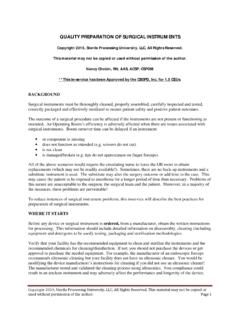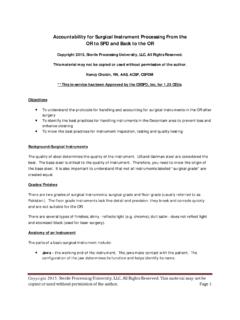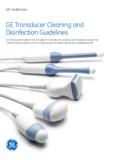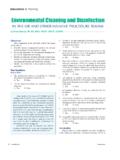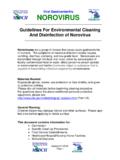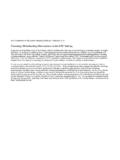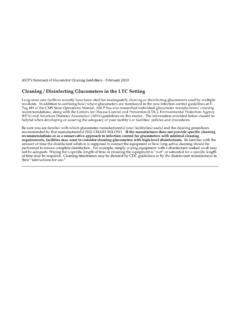Transcription of Best Practices for High Level Disinfection – Part II
1 Best Practices for high Level Disinfection part II. Nancy Chobin, RN, AAS, ACSP, CSPM, CFER. This material may not be published, broadcast, rewritten, or redistributed. 2017 Sterile Processing University, LLC. **This in-service has been Approved by the CBSPD for CEUs. There are many high Level disinfectants on the market today. This module will discuss some of the more popular ones. Glutaraldehydes are high Level disinfectants (HLD) for immersible items. There are acid and alkaline preparations. Some examples of glutaraldehyde-based products include Rapicide, Cidex and Aldahol.
2 As with all HLD, the solution must make contact with all surfaces of the device. Thorough pre-cleaning is essential; all soils must be removed and rinsed off so the Disinfection process can be effective. This category of HLDs is mainly used for flexible and rigid scopes. However, they might also be used for laryngoscope blades that have been validated for HLD using the chemical. These products are generally, non-corrosive to plastic, metal and lensed instruments. They require activation with a buffering agent which gets added to solution in the container.
3 The buffering agent is a powder that gets mixed with the solution inside the container. Once activated, the product is good for 14-28 days depending on the formulation used. Buffering agent This material may not be published, broadcast, rewritten, or redistributed. 2017 Sterile Processing University, LLC. Page 1. The recommended soak time is 10- 45 min depending on the product. However, it is critical that you follow the specific manufacturer's instructions for use including any recommended temperature required. In the high Level Disinfection part I module, you learned that the use life of the product is affected by soils, temperature and in-use dilution.
4 In a 2% solution glutaraldehydes are effective against all vegetative bacteria, viruses, TB and fungi. They can be toxic, and requires thorough rinsing to remove all residues which can cause sloughing of the patient's tissue. The quality of rinse water issue-can re- contaminate device. Consult with your Infection Prevention nurse regarding the water quality for rinsing. Some general guidelines for use of glutaraldehyde solutions follow. Mix them according to manufacturer's instructions. Document on the solution container, the date the solution was made and when it expires.
5 After soaking, thorough rinsing with sterile water recommended to prevent re-contamination (if need to present sterile otherwise utility [potable] water). NOTE: The quantity and quality of water must be followed for the specific disinfectant used. After high Level Disinfection , protect the device from re-contamination until used. Always use glutaraldehydes in a well-ventilated, restricted area. For safety, there are personnel monitoring devices and neutralization pads available. Neutralization Pads These devices are specifically designed to both absorb and neutralize small spills.
6 They have a plastic backing for extra protection. The pad is placed under and around soaking basins. The pad eliminates the need to use towels which can expose personnel to fumes. QA Testing of Test Strips Read the package insert to determine if your test strip manufacturer recommends quality control testing of the test strips whenever a new bottle is opened. When a new bottle is opened, you should date the bottle when opened and note the expiration date (this is based on the manufacturer's instructions). If quality control testing of the test strips is recommended, always follow the test strip manufacturer's testing instructions.
7 Quality control testing of the strips should be documented on a separate form from the Minimum Effective Concentration (MEC) testing discussed in Module I. Personal Protective Equipment (PPE) - PPE should include eye shields, fluid resistant mask (to prevent splashes onto mucous membranes of the face), butyl rubber gloves (no vinyl or neoprene gloves), and a polyethylene gown (plastic) with long sleeves. You should consult with the Safety Data Sheet and the manufacturer's instructions for use to verify the recommended PPE for the product you are using.
8 Safety Once in use, the solution should always be stored covered. There is an OSHA Ceiling limit for glutaraldehyde exposure of The American Congress of Governmental and Industrial Hygienists (ACGIH) recommend a Level of ppm. In the absence of an OSHA standard, OSHA defers to the ACGIH Level of ppm. Therefore, when testing for glutaraldehyde levels of staff, the Level should be ppm. This means at no time can the Level exceed ppm. The levels should be determined This material may not be published, broadcast, rewritten, or redistributed.
9 2017 Sterile Processing University, LLC. Page 2. annually with a glutaraldemeter (this is the most accurate reading). A spill plan is needed. Consult with the Safety Data Sheet for the recommended neutralization agent. Understand that disposal of the solution is the number one cause of exposure for users (dumping down drain). When disposing, the solution should be diluted with copious amounts of running water. Follow the manufacturer's instructions for disposal. Dispose of the disinfectant containers per the label instructions.
10 There are many formulations of glutaraldehyde in use today such as: Cidex . Aldahol . Rapicide . Banicide Advanced . Sporicidin . Cetylcide-G . Procide-D . Omnicide . Metricide . Wavicide-01 . Some of these formulations are only validated for use in automated endoscope reprocessors (AERs). There are additional formulations; all are listed on the FDA website. Ortho-phthalaldehyde ( ) Cidex OPA is a non-glutaraldehyde product. It is non-toxic. The chemical requires a 12 minute soak time for manual high Level Disinfection at MINIMUM of 68oF (20oC).


